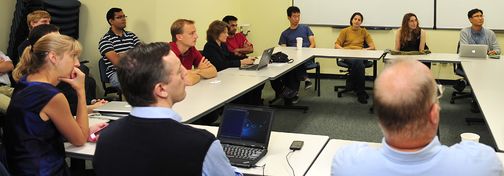Events: Difference between revisions
Computational Linguistics and Information Processing
No edit summary |
No edit summary |
||
| Line 15: | Line 15: | ||
}} | }} | ||
--> | --> | ||
== 9/4/2013 and 9/11/2013: N-Minute Madness == | |||
The people of CLIP talk about what's going on in N minutes. <b>Special location note</b>: on 9/4/2013, we'll be in AVW 4172. | |||
== 9/18/2013: Spatio-Temporal Crime Prediction using GPS- and Time-Tagged Tweets == | == 9/18/2013: Spatio-Temporal Crime Prediction using GPS- and Time-Tagged Tweets == | ||
Revision as of 11:26, 30 August 2013

The CLIP Colloquium is a weekly speaker series organized and hosted by CLIP Lab. The talks are open to everyone. Most talks are held at 11AM in AV Williams 3258 unless otherwise noted. Typically, external speakers have slots for one-on-one meetings with Maryland researchers before and after the talks; contact the host if you'd like to have a meeting.
If you would like to get on the cl-colloquium@umiacs.umd.edu list or for other questions about the colloquium series, e-mail Jimmy Lin, the current organizer.
9/4/2013 and 9/11/2013: N-Minute Madness
The people of CLIP talk about what's going on in N minutes. Special location note: on 9/4/2013, we'll be in AVW 4172.
9/18/2013: Spatio-Temporal Crime Prediction using GPS- and Time-Tagged Tweets
Matthew Gerber
Recent research has shown that social media messages (e.g., tweets) can be used to predict various large-scale events like elections (Bermingham and Smeaton, 2011), infectious disease outbreaks (St. Louis and Zorlu, 2012), and even national revolutions (Howard et al., 2011). The essential hypothesis is that the timing, location, and content of these messages are informative with regard to such future events. For many years, the Predictive Technology Laboratory at the University of Virginia has been constructing statistical prediction models of criminal incidents (e.g., robberies and assaults), and we have recently found preliminary evidence of Twitter’s predictive power in this domain (Wang, Brown, and Gerber, 2012). In my talk, I will present an overview of our crime prediction research with a specific focus on current Twitter-based approaches. I will discuss (1) how precise locations and times of tweets have been integrated into the crime prediction model, and (2) how the textual content of tweets has been integrated into the model via latent Dirichlet allocation. I will present current results of our research in this area and discuss future areas of investigation.
About the Speaker: Matthew Gerber joined the University of Virginia faculty in 2011 and is currently a Research Assistant Professor in the Department of Systems and Information Engineering. Prior to joining the University of Virginia, Matthew was a Ph.D. candidate in the Department of Computer Science and Engineering at Michigan State University and a Visiting Instructor in the School of Computing and Information Systems at Grand Valley State University. In 2010, he received (jointly with Joyce Chai) the ACL Best Long Paper Award for his work on recovering null-instantiated arguments for semantic role labeling. His current research focuses on the semantic analysis of natural language text and its application to various prediction and informatics problems.